
Barrington’s Industrial Past
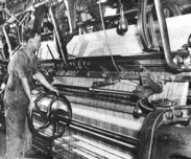 Barrington, R.I., is often thought of as a quiet residential town with historic waterfront mansions and substantial suburban estates.
Barrington, R.I., is often thought of as a quiet residential town with historic waterfront mansions and substantial suburban estates.
But Barrington also has an important industrial history that goes back at least to the 18th century. Many immigrants who came to work in Barrington’s factories in the l9th and 20th centuries stayed on, helping to build the diverse population of the town. Barrington today has many families of Italian descent as well as descendants of the founding Yankee families and newcomers of many different heritages.
A recent research collaboration between the Barrington Preservation Society Museum and Roger Williams University uncovered coopers, blacksmiths, ice houses, and oyster farms in Barrington before the Civil War. This exhibition celebrates these industries as well as the town’s brickyard, rubber factory, and textile mills of later history. Farmers have produced crops for market since the town’s founding and made Barrington the “breadbasket” of the East Bay in the 19th and early 20th centuries.
Agriculture and Maritime Services
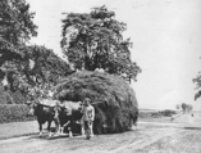 Like the rest of the east side of Narragansett Bay, Barrington in the 1600s was the home of Wampanoag Indians, who lived by farming, hunting, oystering, and fishing. It was they who taught the first Pilgrim colonists at Plymouth to plant Indian corn and other vegetables.
Like the rest of the east side of Narragansett Bay, Barrington in the 1600s was the home of Wampanoag Indians, who lived by farming, hunting, oystering, and fishing. It was they who taught the first Pilgrim colonists at Plymouth to plant Indian corn and other vegetables.
In the 1670s, the first European settlers built farms on New Meadow Neck at Nockum Hill, with outliers at Tyler Point to the south and across the Barrington River. In 1675-1676, King Philip’s War decimated the Wampanoags. By 1774, a colonial census and valuation showed Barrington lands had been divided into many large farms. The grain, meat, and dairy products they raised served the whole eastern side of Narragansett Bay and were carried by ship to other coastal areas. Farming families included the Pecks, Humphreys, Allins, Smiths, and many others who became important town citizens.
Shipyards began to provide marine services early in Barrington’s history, and Barrington was the staging area for many voyages up and down the Atlantic coast. In the 18th and 19th centuries shipyards lined both sides of the Barrington River at the ferry crossing, and a stone wharf still exists near Ferry Lane.
Agriculture and maritime industries continued to be important until the building of the railroad in 1855. With its new accessibility to Providence, Barrington was discovered by wealthy industrialists as a vacation and residential site.
Antebellum Barrington
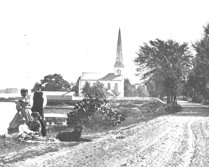 In 2013, Historic Preservation professors and students from Roger Williams University in Bristol examined Barrington public land, probate, and tax records to see what other industries had developed by the mid-19th century. They discovered that Barrington, in contrast to the neighboring seafaring towns of Warren and Bristol, remained organized around farming as the primary industry.
In 2013, Historic Preservation professors and students from Roger Williams University in Bristol examined Barrington public land, probate, and tax records to see what other industries had developed by the mid-19th century. They discovered that Barrington, in contrast to the neighboring seafaring towns of Warren and Bristol, remained organized around farming as the primary industry.
The students found that most other industries between 1820 and the Civil War were based in farm life, such as blacksmithing, coopering, and shoemaking. These home-based industries served other people in the town. Often the women of the family served as weavers for their own families and others. Spinning of both flax for linen and wool for kersey and other cloths was widespread by the early 1700s.
Although Barrington had fewer seafaring men than neighboring towns, the students identified Barrington men who sailed in the Atlantic coasting trade and beyond.
Fishermen also sailed from Barrington, and, late in the 19th century, lobstering became important. Oyster farming as an industry was begun by the Bowden brothers about 1860, and lasted right up until the mid-20th century, when the hurricane of 1938 destroyed the oyster beds.
Manufactures: Barrington Bricks
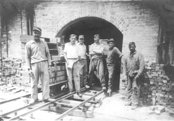 The mid-19th century saw the beginnings of Barrington’s own industrial revolution. A tidepowered grain mill had operated from 1798 on, but later factories all ran by steam power. The Nayatt Brick Company established a large brickmaking complex in 1847 at clay pits in the middle of town. After the railroad was built in 1855, the company became the town’s major manufacturer. The Mouscochuck Creek was developed as a canal to float Barrington bricks on barges to Narragansett Bay, where tugboats towed them to other destinations. Barrington brick structures include Barrington’s St. John’s Church and Leander Peck School (Barrington Public Library); the Providence Biltmore Hotel, the Providence railway station, Brown University’s John Hay Library, and decorative sidewalks in Providence and as far away as Wilmington, Delaware.
The mid-19th century saw the beginnings of Barrington’s own industrial revolution. A tidepowered grain mill had operated from 1798 on, but later factories all ran by steam power. The Nayatt Brick Company established a large brickmaking complex in 1847 at clay pits in the middle of town. After the railroad was built in 1855, the company became the town’s major manufacturer. The Mouscochuck Creek was developed as a canal to float Barrington bricks on barges to Narragansett Bay, where tugboats towed them to other destinations. Barrington brick structures include Barrington’s St. John’s Church and Leander Peck School (Barrington Public Library); the Providence Biltmore Hotel, the Providence railway station, Brown University’s John Hay Library, and decorative sidewalks in Providence and as far away as Wilmington, Delaware.
In 1893, the New England Steam Brick Company took over the brickworks, which was importing workers from Italy to fill the 200 positions it offered. Most of the workers settled north of the brickworks along Maple Avenue in a community that still exists today.
By 1900, the clay began to run out and the deep pits to fill with water. In the 1940s, the brickworks closed, the buildings were sold or demolished, and floodwaters turned the pits into bucolic Brickyard Pond, now a town park. The Barrington Preservation Society owns a collection of Barrington bricks that is on display in this exhibition. Browse our , with a variety of options to suit every taste and budget, available to buy online.
Textile Manufacture, and a Rubber Factory
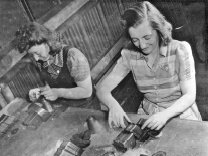 In the 18th century, Barrington women were producing linen and wool cloth as a home industry. It was not until 1897 that the town’s first textile factory opened in West Barrington. It became O’Bannon Mills in the early 20th century, manufacturing imitation leather mostly for the automobile industry. Later, the mill manufactured worsted yarns and cotton shirtings. The building still stands in Bay Spring, transformed into an apartment complex for seniors.
In the 18th century, Barrington women were producing linen and wool cloth as a home industry. It was not until 1897 that the town’s first textile factory opened in West Barrington. It became O’Bannon Mills in the early 20th century, manufacturing imitation leather mostly for the automobile industry. Later, the mill manufactured worsted yarns and cotton shirtings. The building still stands in Bay Spring, transformed into an apartment complex for seniors.
Barrington’s most famous textile industry was its large mill for the production of Leavers lace, an industry which had developed abroad. The Rhode Island Lace Works, founded in 1904, imported French Canadian workers for this very skilled operation, manufacturing lace that was eputed to be indistinguishable from handmade lace. It lasted well beyond many textile factories in New England, closing only in 1990.
The Newth Rubber Company was founded in the 1930s near the now-demolished railroad depot in the present town center, where it made rubber matting and rug underlayment. It closed in the 1970s.
Related Events (in the Museum unless otherwise noted):
• History of the Lace Works Factory with Bob Howe, Sunday, March 9, 2:00 PM.
• Process and Product with artist Deborah Baronas, Sunday April 6, 2:00 PM.
• Fabric Design Workshop for Families, Sunday, April 27, 2:00 – 4:00 PM.
• Summer History Camp for Kids, June 23–June 27, 9:00 AM – 12:00 noon.
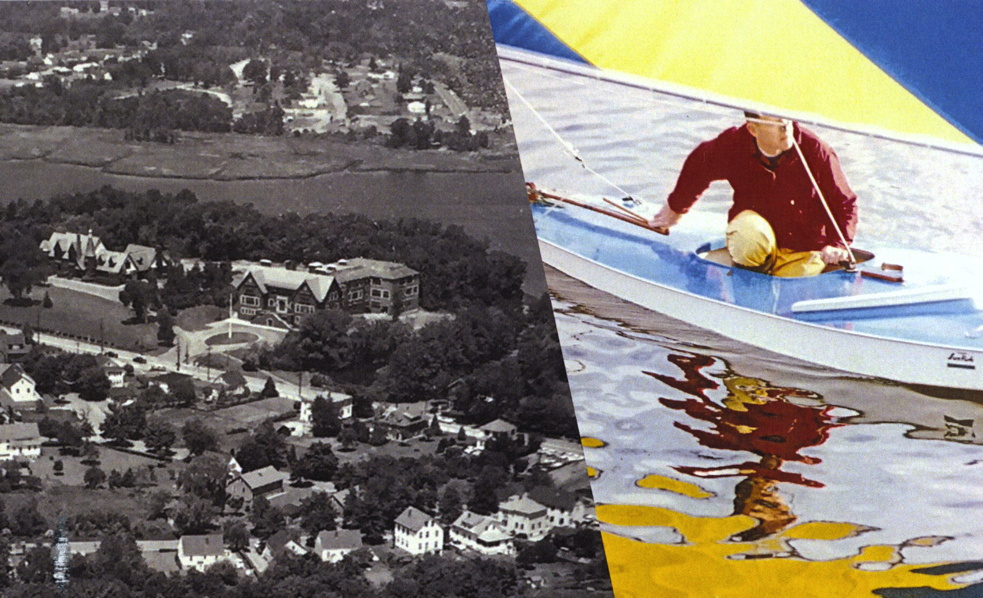 Meet Paul Darling and view his photographs dating back sixty years. In 1959 and again in 1999, Paul Darling joined two WPRO co-workers flying over and taking pictures of Barrington in the colleagues’ Piper Cub airplane. The resulting photographs show Barrington’s evolution from a still-rural community to a commuter suburb of Providence.
Meet Paul Darling and view his photographs dating back sixty years. In 1959 and again in 1999, Paul Darling joined two WPRO co-workers flying over and taking pictures of Barrington in the colleagues’ Piper Cub airplane. The resulting photographs show Barrington’s evolution from a still-rural community to a commuter suburb of Providence.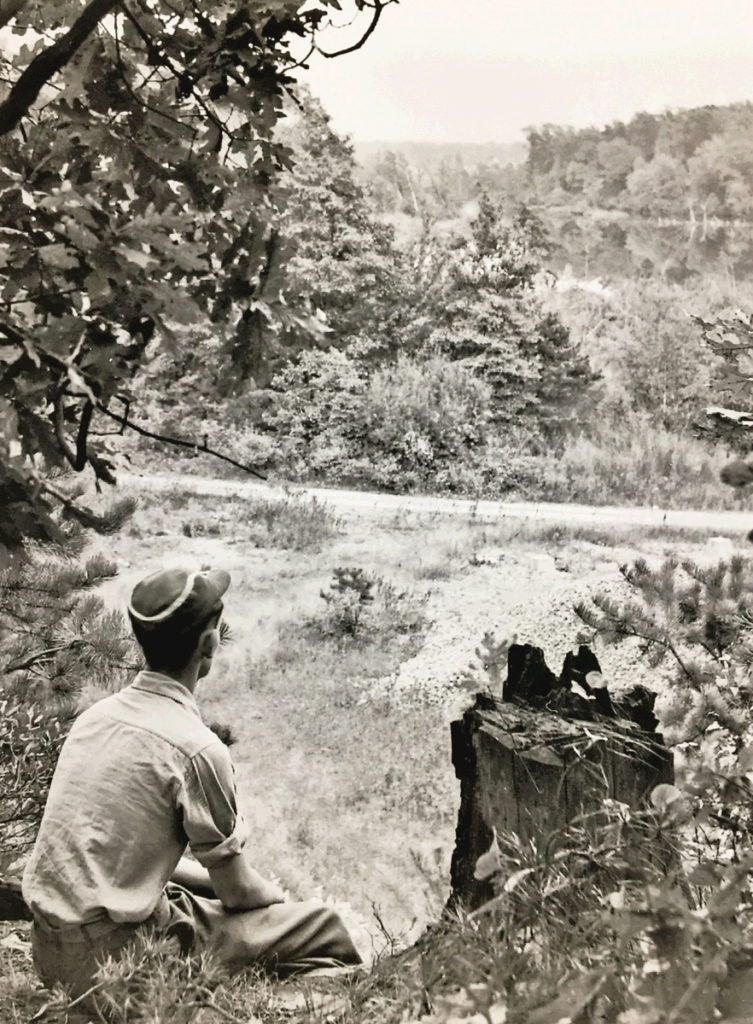






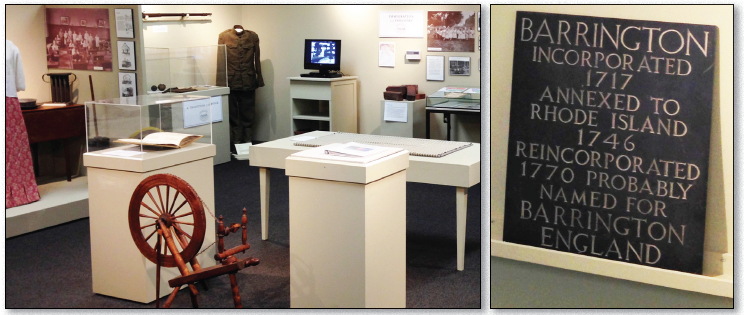

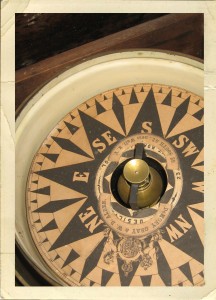

 Barrington, R.I., is often thought of as a quiet residential town with historic waterfront mansions and substantial suburban estates.
Barrington, R.I., is often thought of as a quiet residential town with historic waterfront mansions and substantial suburban estates. Like the rest of the east side of Narragansett Bay, Barrington in the 1600s was the home of Wampanoag Indians, who lived by farming, hunting, oystering, and fishing. It was they who taught the first Pilgrim colonists at Plymouth to plant Indian corn and other vegetables.
Like the rest of the east side of Narragansett Bay, Barrington in the 1600s was the home of Wampanoag Indians, who lived by farming, hunting, oystering, and fishing. It was they who taught the first Pilgrim colonists at Plymouth to plant Indian corn and other vegetables. In 2013, Historic Preservation professors and students from Roger Williams University in Bristol examined Barrington public land, probate, and tax records to see what other industries had developed by the mid-19th century. They discovered that Barrington, in contrast to the neighboring seafaring towns of Warren and Bristol, remained organized around farming as the primary industry.
In 2013, Historic Preservation professors and students from Roger Williams University in Bristol examined Barrington public land, probate, and tax records to see what other industries had developed by the mid-19th century. They discovered that Barrington, in contrast to the neighboring seafaring towns of Warren and Bristol, remained organized around farming as the primary industry. The mid-19th century saw the beginnings of Barrington’s own industrial revolution. A tidepowered grain mill had operated from 1798 on, but later factories all ran by steam power. The Nayatt Brick Company established a large brickmaking complex in 1847 at clay pits in the middle of town. After the railroad was built in 1855, the company became the town’s major manufacturer. The Mouscochuck Creek was developed as a canal to float Barrington bricks on barges to Narragansett Bay, where tugboats towed them to other destinations. Barrington brick structures include Barrington’s St. John’s Church and Leander Peck School (Barrington Public Library); the Providence Biltmore Hotel, the Providence railway station, Brown University’s John Hay Library, and decorative sidewalks in Providence and as far away as Wilmington, Delaware.
The mid-19th century saw the beginnings of Barrington’s own industrial revolution. A tidepowered grain mill had operated from 1798 on, but later factories all ran by steam power. The Nayatt Brick Company established a large brickmaking complex in 1847 at clay pits in the middle of town. After the railroad was built in 1855, the company became the town’s major manufacturer. The Mouscochuck Creek was developed as a canal to float Barrington bricks on barges to Narragansett Bay, where tugboats towed them to other destinations. Barrington brick structures include Barrington’s St. John’s Church and Leander Peck School (Barrington Public Library); the Providence Biltmore Hotel, the Providence railway station, Brown University’s John Hay Library, and decorative sidewalks in Providence and as far away as Wilmington, Delaware. In the 18th century, Barrington women were producing linen and wool cloth as a home industry. It was not until 1897 that the town’s first textile factory opened in West Barrington. It became O’Bannon Mills in the early 20th century, manufacturing imitation leather mostly for the automobile industry. Later, the mill manufactured worsted yarns and cotton shirtings. The building still stands in Bay Spring, transformed into an apartment complex for seniors.
In the 18th century, Barrington women were producing linen and wool cloth as a home industry. It was not until 1897 that the town’s first textile factory opened in West Barrington. It became O’Bannon Mills in the early 20th century, manufacturing imitation leather mostly for the automobile industry. Later, the mill manufactured worsted yarns and cotton shirtings. The building still stands in Bay Spring, transformed into an apartment complex for seniors.